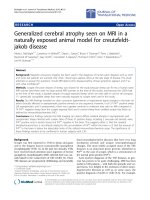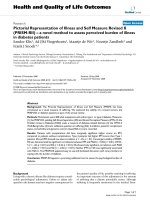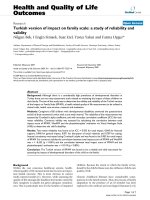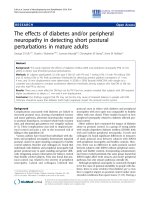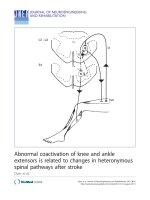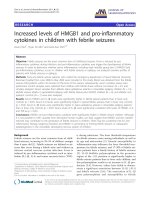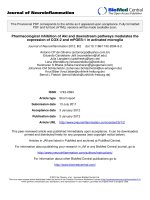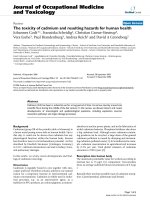báo cáo hóa học: " Turkish version of impact on family scale: a study of reliability and validity" doc
Bạn đang xem bản rút gọn của tài liệu. Xem và tải ngay bản đầy đủ của tài liệu tại đây (460.87 KB, 7 trang )
BioMed Central
Page 1 of 7
(page number not for citation purposes)
Health and Quality of Life
Outcomes
Open Access
Research
Turkish version of impact on family scale: a study of reliability and
validity
Nilgun Bek, I Engin Simsek, Suat Erel, Yavuz Yakut and Fatma Uygur*
Address: Department of Physical Therapy and Rehabilitation, Faculty of Health Sciences, Hacettepe University, Ankara, Turkey
Email: Nilgun Bek - ; I Engin Simsek - ; Suat Erel - ;
Yavuz Yakut - ; Fatma Uygur* -
* Corresponding author
Abstract
Background: Although there is a considerably high prevalence of developmental disorders in
Turkey there are not many assessment tools related to evaluating the impact of these children on
their family. The aim of this study was to determine the validity and reliability of the Turkish version
of the Impact on Family Scale (IPFAM), a health related quality of life measurement to be utilized in
clinical trials, health care services, research and evaluation.
Methods: Caregivers of 85 children with developmental disabilities answered the questionnaire
and 65 of them answered it twice with a one week interval. The reliability of the measurement was
assessed by Cronbach's alpha coefficient, and with intraclass correlation coefficient (ICC) for test-
retest reliability. Construct validity was assessed by calculating the correlation between total
impact score of IPFAM, WeeFIM and the physiotherapists' evaluation via Visual Analogue Scale
(VAS) to determine the child's disability.
Results: Test-retest reliability was found to be ICC = 0.953 for total impact, 0.843 for financial
support, 0.940 for general impact, 0.871 for disruption of social relations and 0.787 for coping.
Internal consistency was tested using Cronbach's alpha and was found to be 0.902 for total impact
of IPFAM. For construct validity the correlation between total impact score of IPFAM and WeeFIM
was r = -0,532 (p < 0.001) and the correlation between total impact score of IPFAM and the
physiotherapist's evaluation was r = 0.519 (p < 0.001).
Conclusion: The Turkish version of IPFAM was found to be a reliable and valid instrument for
assessing the impact of developmental disorders of the child on the family.
Background
Within the cost conscious healthcare system, health-
related quality of life measurement has become an impor-
tant health outcome. This is most obvious in current
multi-centered studies [1]. However, while assessing the
quality of life amongst the disabled, the burden carried by
their caregivers is usually not given adequate considera-
tion. This is particularly true for the families of impaired
children. Because the extent to which the family is bur-
dened by the child's illness may also influence child's own
quality of life.
Chronic childhood illnesses have considerable conse-
quences for the family system. Thus, the process of family
adaptation to the presence of an ill member has been
explored in the medical and sociological literature [2,3].
Published: 28 January 2009
Health and Quality of Life Outcomes 2009, 7:4 doi:10.1186/1477-7525-7-4
Received: 20 November 2007
Accepted: 28 January 2009
This article is available from: />© 2009 Bek et al; licensee BioMed Central Ltd.
This is an Open Access article distributed under the terms of the Creative Commons Attribution License ( />),
which permits unrestricted use, distribution, and reproduction in any medium, provided the original work is properly cited.
Health and Quality of Life Outcomes 2009, 7:4 />Page 2 of 7
(page number not for citation purposes)
Various studies have been carried out examining family
burden associated with psychiatrically disturbed youth [4-
6]. Researchers have stated that understanding the experi-
ence of family burden in this population is crucial since
the emotional, social and financial cost of living with a
disturbed youngster may affect the mental health of fam-
ily members, while playing a role in decisions to seek out
and use children's mental health services [4]. Moreover,
Riley et al. states that this line of research enables decision
makers to compare different treatments not only in terms
of costs but also valued outcomes [7].
These statements also hold true for children with develop-
mental disorders such as cerebral palsy, meningomyolecel
etc.; because whether the problem is a chronic illness, a
psychiatric disorder or a developmental disorder, there
will be an impact on the families' daily routines.
Stein and Riessman have developed the Impact on Family
Scale which was designed to measure the impact of pedi-
atric chronic health conditions on parents and family.
They published their preliminary findings in 1980 [3]. In
their study, impact was defined as the effects of a child's
illness on the family system. The implicit assumption was
that changes occur in the family because of illness, forcing
adaptations in the family environment [3]. The Impact on
Family Scale is a 27-item inventory that takes approxi-
mately 10 minutes to complete and can be used either as
a questionnaire, when reading levels are adequate, or an
interviewer-administered form [8]. Five dimensions are
assessed: 1) economic burden or the extent to which the
illness changes the economic status of the family, 2) social
impact, or the quality and quantity of interaction with
others outside the immediate family, 3) familial impact,
the quality of interaction within the family unit, 4) per-
sonal strain, subjective burden experienced by the primary
caregiver, and 5) Coping, strategies employed by the fam-
ily to master the stress of an illness or disability of the
child. All items have a standard four point scale ranging
from strongly agree to strongly disagree.
As in the whole world, there is an increasing interest to
assess health related quality of life in Turkey. Although
there is considerably high chronic childhood disease prev-
alence, especially muscle diseases due to marriage among
first degree relatives such as cousins, there are not many
assessment tools related to children in Turkish. So far, the
Turkish versions of the Childhood Health Assessment
Questionnaire (CHAQ), the Child Health Questionnaire
(CHQ) and Functional Independence Measure of Chil-
dren (WeeFIM) have been studied for reliability and valid-
ity [1,9-11].
Direct translation of questionnaires into other languages
does not guarantee maintenance of validity. It is well rec-
ognized that if measures are to be used across cultures, the
items must not only be well translated linguistically, but
also adapted culturally in order to maintain the content
validity of the instrument across different cultures [12].
The purpose of this study was to develop the Turkish ver-
sion of the Family Impact Scale and to examine whether it
is a valid and reliable tool for assessing the impact of hav-
ing a child with chronic disability on family life.
Methods
Procedure
This study is divided into two phases: Phase I, the cross-
cultural adaptation, which involves the translation proce-
dures and preliminary probe in the target population; and
phase II, which involves the reliability and validation
Table 2: Data related to the IPFAM dimensions, WeeFIM and physiotherapist's assessment.
Test
X ± SD
Retest
X ± SD
Total Impact 52.02 ± 12.09 51.74 ± 11.62
Financial Support 8.69 ± 2.41 8.68 ± 2.33
General Impact 26.95 ± 6.29 26.70 ± 6.07
Disruption of Social Relation 22.15 ± 6.05 22.04 ± 5.74
Coping 6.47 ± 2 6.74 ± 2.05
Physiotherapist's Assessment (VAS mm) 44.27 ± 28.82 -
WeeFIM 72.17 ± 41.56 -
Table 1: Demographic data's of participants.
X ± SD
Age (children) (years) 6.52 ± 3.33
Education level of parents (years)
Mother 7.95 ± 3.77
Father 9.33 ± 3.74
n (%)
Health insurance
With 79 (93)
Without 6 (7)
Marital status
Married 82 (96)
Divorced 3 (4)
Residence
Living with parent 85 (100)
Health and Quality of Life Outcomes 2009, 7:4 />Page 3 of 7
(page number not for citation purposes)
study. Phase I: Cross cultural adaptation process followed
the guidelines provided by Guillemin et al, Beaton et al.
and Ruperto et al. [[1,13], and [14]]. Two forward transla-
tions were carried out by independent translators from
English to their native language which is Turkish. A meet-
ing was then convened among the two forward translators
and four other physiotherapists not involved in the trans-
lation procedures but who were experienced in treating
children with chronic disabilities. The goal of this meeting
was to reach a consensus among the members of the
group to obtain the first unified version of the two for-
ward translations. This version was then back translated
by two independent translators whose native language
was English. They were fluent into the idioms and collo-
quial forms of the forward language. The two back trans-
lators had not seen the original English text of the Family
Impact Scale and were unaware of the purpose of the
project. The two backward translations were then
reviewed by two of the authors of this paper. The aim of
this phase was to ascertain that the translation was fully
comprehensible and a concordance with the English ver-
sion was attained. Following this phase a second meeting
was held with participation of all the interested profes-
sionals. The purpose of this meeting was to reach a final
consensus. To ensure that the adapted version still retains
its equivalence in an applied situation, the last stage of the
adaptation process was to test the pre-final version in a
pilot study. A health professional experienced in treating
chronic childhood diseases administered the question-
naire to the parents, asking them to consider each ques-
tion in a critical manner and judged whether the
questions were understood. The only problematic item in
this stage was "sometimes I fell like we live on a roller
coaster " because roller coaster did not convey an appro-
priate meaning for the Turkish population. This word was
replaced with another descriptor conveying the same
meaning. This version was finalized with consensus of a
bilingual team experienced in treating children with
chronic disabilities as advocated by former researchers
[[1,13], and [14]].
The scoring of the IPFAM was done according to the scor-
ing instructions given in the PACTS PAPERS/AECOM
[15]. The results obtained were computed under the head-
ings Total Impact, Financial Support, General Impact, Dis-
ruption of Social Relations and Coping for statistical
analysis. Although IPFAM originally had 27 items, due to
precise scoring instructions, we used 24 items and the
revised scoring based on PACTS data. We recoded the
given items to the opposite; so that low impact had the
lower score. However, total impact is not the mere sum of
the 24 items. It does not include the items with a positive
implication which did not require to be recoded to the
opposite direction.
Participants
Informed consent was obtained from all subjects and eth-
ical approval was obtained from the University's Ethics
Committee.
The caregiver parent of 85 children between the ages of
one and nine years (mean ± standard deviation = 6.52 ±
3.33 years) participated in the study. Eighty-five children
of which 50 (59%) were with a diagnosis of cerebral palsy,
23 (27%) with muscular disease, 6 (7%) with mental
motor retardation, 4 (5%) with spina bifida, 2 (2%) with
meningitis, were recruited among the patients receiving
physiotherapy in a University Hospital who volunteered
Table 4: Inter-subscale and subscale – total correlation matrix for test.
Total Impact Financial Support General Impact Disruption of Social Relations Coping
r (p) r (p) r (p) r (p) r (p)
Total Impact -
Financial Support 0.742 (0.000)* -
General Impact 0.957 (0.000)* 0.670 (0.000)* -
Disruption of Social Relations 0.925 (0.000)* 0.637 (0.000)* 0.851 (0.000)* -
Coping -0.107 (0.332) -0.086 (0.435) -0.036 (0.742) -0.016 (0.886) -
*: p < 0.01.
Table 3: Data related to the IPFAM dimensions with standardized scores
Number of items Test
X ± SD
Retest
X ± SD
Total Impact 19 2.74 ± 0.64 2.72 ± 0.61
Financial Support 3 2.90 ± 0.80 2.89 ± 0.78
General Impact 10 2.70 ± 0.63 2.67 ± 0.61
Disruption of Social Relation 9 2.46 ± 0.67 2.45 ± 0.64
Coping 4 1.62 ± 0.50 1.69 ± 0.51
Health and Quality of Life Outcomes 2009, 7:4 />Page 4 of 7
(page number not for citation purposes)
to take part in the study, so they constituted a sample of
convenience. No inclusion criterion was identified except
having at least one child with a disability who is one year
old or older. The participants were asked to answer the
questionnaire for a second time, after an interval of one
week. Relevant socio-demographic data were given in
Table 1.
Data analysis
There were no missing values for the test or retest of the
items of IPFAM. However, 20 parents were not able to
complete the retest due to unexpected health problems,
vacations, and because they lived in other cities and came
for treatment on a bimonthly or monthly basis. The com-
pletion duration of the test was between 8 to 12 minutes
Reliability
Cronbach's alpha was used to assess the internal consist-
ency of the IPFAM. Also, subscales to total and inter-sub-
scale, correlations were used to evaluate internal
consistency with Pearson correlation analysis. Test-retest
values of subgroups and total scores were compared with
the Wilcoxon signed rank test (two-tailed). The test-retest
reliability was calculated on the answers of 65 parents
who were able to complete the questionnaire twice with
an interval of one week by using intra-class correlation
coefficient (ICC).
Validity
Construct validity was evaluated by hypothesizing how
the measure should behave and confirming or discon-
firming this hypothesis. Thus, construct validity was
investigated through an analysis of the intercorrelations
among the items with the benchmark criterion. One of
the benchmarks was the physiotherapist's evaluation of
disability intensity on a 10 cm visual analogue scale (VAS)
anchored with negligible disability to total disability. The
physiotherapist who carried out the evaluation of disabil-
ity had specialized in pediatric rehabilitation and had
been treating the child for at least three months. Construct
validity was also measured by comparing the IPFAM
responses with the results of The Functional Independ-
ence Measure for Children (WeeFIM). WeeFIM is an 18
item, 7 level ordinal scale instrument that measures a
child's consistent performance in essential daily func-
tional skills such as self-care, sphincter control, transfers,
locomotion, communication and social cognition under
three main domains which are self-care, mobility and cog-
nition [16,17]. Our choice of using WeeFIM was based on
the age span of our children with developmental disabili-
ties and on the assumption that functional independence
of a child is directly proportional to the burden of care
affecting the family. We chose WeeFIM also because the
reliability and validity of the Turkish version has been
demonstrated [11].
All statistical analysis was done with SPSS 10.0 for Win-
dows. A probability value of p < 0.05 was considered to
indicate a significant effect.
Results
The means and standard deviations of the five dimensions
of IPFAM, the physiotherapists' assessment and WeeFIM
are shown in Table 2. To enable comparisons, we stand-
ardized the scores by dividing each subscale score by the
number of items used to produce it (Table 3).
According to the Wilcoxon signed rank test, there was no
difference between test and retest values of the total
impact, financial support, general impact, disruption of
social relations and coping (p < 0.05).
Table 6: Test – retest reliability.
ICC (95% Confidence Interval)
Total Impact 0.953 (0.928–0.969)
Financial Support 0.843 (0.767–0.895)
General Impact 0.940 (0.909–0.961)
Disruption of Social Relation 0.871 (0.807–0.914)
Coping 0.787 (0.690–0.856)
Table 5: Reliability Analysis Cronbach's Alpha.
Number of items Alpha Coefficient
Total Impact 19 0.902
Financial Support 30.715
General Impact 10 0.796
Disruption of Social Relation 90.825
Coping 40.439
Number of items Alpha Coefficient
Total Impact 19 0.902
Financial Support 30.715
General Impact 10 0.796
Disruption of Social Relation 90.825
Coping 40.439
Health and Quality of Life Outcomes 2009, 7:4 />Page 5 of 7
(page number not for citation purposes)
Inter-subscale correlations were found to be between r = -
0,016 and r = 0,851. However coping subscale was not sig-
nificantly correlated to any other subscales. Thus, not sur-
prisingly when coping was excluded inter-subscale
correlations were calculated as between r = 0,637 and r =
0,851 (p < 0.05).
The same was also true for subscale to total correlation
analysis. The correlations between subscales and total
impact score ranged between r = -0,107 and r = 0,957.
There was no correlation between coping and total
impact. The average subscale to total impact correlation
was 0.875 when coping was excluded (Table 4).
Reliability
For internal consistency reliability analysis, Cronbach's
alpha was calculated to be 0,902 for total impact score
(Table 5).
Test-retest reliability was found to be ICC = 0.953 for total
impact, 0.843 for financial support, 0.940 for general
impact, 0.871 for disruption of social relations and 0.787
for coping (Table 6).
Validity
Correlation between the total impact score of IPFAM and
WeeFIM, and between the total impact score of IPFAM
and physiotherapists' evaluation via VAS were tested for
construct validity. The resulting correlation was r = -0.532
(p < 0.001) for WeeFIM and 0.519 (p < 0.001) for VAS
(Table 7). Correlations between IPFAM and WeeFIM at
subscale level showed good construct validity except cop-
ing subscale (Table 8).
Discussion
Despite the significant social and emotional costs of car-
ing for an ill or disabled child, the majority of studies aim-
ing to measure the impact on families are mainly
developed in the English language.
A translation on which a consensus was obtained was our
first objective. In our study, the Turkish version did not
require any changes except for the concept of 'roller
coaster' in place of which a phrase was found conveying
the same meaning. Consequently, it was concluded that
the questionnaire was easily comprehensible to the Turk-
ish population.
The absence of missing values in the test may be due to the
fact that the respondents constituted a sample of conven-
ience from the parents whose children were receiving rou-
tine physiotherapy. Consequently they may have felt
obliged to answer the whole questionnaire. We believe
this may be a weakness of the study, since response rates
may not hold true for a general population.
When data related to IPFAM dimensions are observed in
Tables 2, 3 and 4, the average inter-subscale and subscale
to total impact correlations were found to be higher when
coping was excluded. These results indicate that although
it may give valuable information about a family's ability
to master the daily burden, IPFAM without coping sub-
scale may in fact provide more precise and realistic infor-
mation as a whole diagnostic tool for the actual impact.
The fact that the item-level mean score related to coping is
1.6 whereas the other subscales have means of 2.4 – 2.7
show that families are coping extremely well in spite of
the impact they report about their child's disability on
aspects of their lives seems incongruous. This result may
be due to the social and cultural characteristics of the
Turkish population. However, the inconsistency related to
coping is in concurrence with other studies [2,8]. Also
when the values of table 3 are observed the financial con-
sequences of having a child with a disability seems to have
the most impact on family life.
Another objective was to show that the Turkish version
was a reliable assessment tool for measuring the impact of
having a child with developmental disabilities. Two com-
mon forms of reliability are internal consistency and test-
retest reliability. Internal consistency analysis which refers
to the extent to which the measured variance in the score
Table 8: Correlation between IPFAM subscales and WeeFIM subscales.
Total WeeFIM WeeFIM Self-Care WeeFIM Mobility WeeFIM Cognition
r (p) r (p) r (p) R (p)
Total Impact -0.532 (0.000)* -0.532 (0.000)* -0.522 (0.000)* -0.447 (0.002)*
Financial Support -0.496 (0.000)* -0.439 (0.002)* -0.451 (0.002)* -0.450 (0.002)*
General Impact -0.464 (0.000)* -0.516 (0.000)* -0.490 (0.001)* -0.394 (0.007)*
Disruption of Social Relations -0.472 (0.001)* -0.446 (0.002)* -0.487 (0.001)* -0.409 (0.005)*
Coping -0.058(0.695) 0.017 (0.911) -0.094 (0.536) 0.036 (0.814)
*: p < 0.05
Table 7: Construct validity.
Total Impact
r (p)
Physiotherapist's Assessment (VAS) 0.519 (0.000)
WeeFIM -0.532 (0.000)
Health and Quality of Life Outcomes 2009, 7:4 />Page 6 of 7
(page number not for citation purposes)
reflects the true score rather than random error yielded
good reliability [18]. The Cronbach's Alpha values seen in
Table 5 are consistent with and similar to the internal con-
sistency values for the total PACT sample and the Spanish,
German and Italian versions of IPFAM [2,15,19]. Similar
to the results of a report on PARS III, the reliability esti-
mates for the total impact scores are consistently higher
then those for the subscale scores [20]. The fact that cop-
ing had the lowest internal consistency is also in concur-
rence with other studies [2,8].
Tests-retest reliability measures stability over time, by
administering the same test to the same subjects at two
points in time. In this investigation a time interval of a
week was used. A period of one week interval for test-
retest reliability studies of parent interviews have been
used in other studies [21,22]. We used intra-class correla-
tion coefficient (ICC) to evaluate test-retest reliability
from time one to time two. The results of our study
showed excellent to good test and retest reliability [23].
Family financial status, educational status, age of child,
number of family members may all have an effect on the
family burden from a child's disability and it will be inter-
esting to study these effects in large samples. However in
this preliminary version study, we chose to investigate the
effect of severity of disability by means of two indicators.
Construct validity of the IPFAM was obtained by correlat-
ing it with the physiotherapist's evaluation of the severity
of the child's disability, and demonstrated good validity
[24]. This method is in accordance to the methods uti-
lized in previous studies [6,25-27].
Construct validity of IPFAM was also obtained by correlat-
ing it with WeeFIM total score. There is no other study
which uses WeeFIM as a construct validity criterion for
IPFAM, consequently, we cannot compare our results, but
it demonstrates good validity [24]. This correlation
between the total score of WeeFIM and the total impact
score of IPFAM shows that functional independence of a
child may be a reliable indicator of the burden of which
the family is subjected to. In other terms, as the functional
independence of a child decreases, the impact on the fam-
ily seems to increase which justifies our pre-mentioned
assumption. When the subscales of WeeFIM are correlated
with the subscales of IPFAM the strongest relations were
found between self-care, mobility, total WeeFIM and total
impact.
Translation into different languages and subsequent vali-
dation of questionnaires are of importance for interna-
tional understanding of the measurement properties of
these scales. Such studies enable them to be used in differ-
ent cultural settings and to be utilized with confidence in
cross-cultural comparative research trials [1,5,11,12,28].
The effectiveness of comprehensive pediatric outreach
programs for youngsters with chronic physical disorders
have been tested for their contribution in psychological
and social outcomes and long term mental health benefits
[29,30] We hope that, in the future, the Turkish version of
IPFAM may also be used to evaluate the effects and bene-
fits of social programs aiming to progress family adapta-
tion to community living.
Conclusion
The results of this study indicate that the Turkish version
of the IPFAM is a reliable and valid instrument designed
to assess the impact of pediatric developmental disorders
on parents HRQoL and family functioning. The subscale
inter correlation matrix, total to subscale correlations, test
– retest values and the validity measurements all imply
that when the coping subscale is excluded, IPFAM
becomes a more concise instrument for measuring family
impact. The Turkish version of the IPFAM will be further
field tested on families who have children with various
chronic health conditions and with larger populations of
children.
Competing interests
The authors declare that they have no competing interests.
Authors' contributions
NB designed the study, worked in all stages of data collec-
tion and analysis. IES made substantial contributions to
conception and design, worked in all stages of data collec-
tion and analysis, wrote the first draft. SE made substan-
tial contributions to conception and design, worked in all
stages of data collection, performed the statistical analysis.
YY worked in analysis and interpretation of data, revised
the manuscript for content. FU made substantial contri-
butions to conception and design, was involved in draft-
ing and revising the manuscript. All authors read and
approved the final manuscript.
Acknowledgements
The authors wish to thank Bernadette Akyuz and Susan Kaplan for their
invaluable help with the translation and Ayse Karaduman for her coopera-
tion in improving the Turkish version.
References
1. Ruperto N, Ravelli A, Pistorio A, Malattia C, Cavuto S, Gado-West L,
Tortorelli A, Landgraf JM, Singh G, Martini A, Paediatric Rheumatol-
ogy International Trials Organisation: Cross-cultural adaptation
and psychometric evaluation of the Childhood Health
Assessment Questionnaire (CHAQ) and the Child Health
Questionnaire (CHQ) in 32 countries. Review of the general
methodology. Clin Exp Rheumatol 2001, 19(4 Suppl 23):S1-9.
2. Kolk AM, Schipper JL, Hanewald GJ, Casari EF, Fantino AG: The
Impact-on-Family Scale: a test of invariance across culture.
J Pediatr Psychol 2000, 25:323-329.
3. Stein RE, Riessman CK: The development of an impact-on-fam-
ily scale: preliminary findings. Med Care 1980, 18:465-472.
Publish with Bio Med Central and every
scientist can read your work free of charge
"BioMed Central will be the most significant development for
disseminating the results of biomedical research in our lifetime."
Sir Paul Nurse, Cancer Research UK
Your research papers will be:
available free of charge to the entire biomedical community
peer reviewed and published immediately upon acceptance
cited in PubMed and archived on PubMed Central
yours — you keep the copyright
Submit your manuscript here:
/>BioMedcentral
Health and Quality of Life Outcomes 2009, 7:4 />Page 7 of 7
(page number not for citation purposes)
4. Messer SC, Angold A, Costello EJ, Burns BJ: The child and adoles-
cent burden assessment (CABA): measuring the family
impact of emotional and behavioral problems. Int J Methods
Psychiatr Res 1996, 6:261-284.
5. Angold A, Costello EJ: The child and adolescent psychiatric
assessment (CAPA). J Am Acad Child Adolesc Psychiatry 2000,
39:39-48.
6. Angold A, Messer SC, Stangl D, Farmer EMZ, Costello EJ, Burns BJ:
Perceived parental burden and service use for child and ado-
lescent psychiatric disorders. Am J Public Health 1998, 88:75-80.
7. Riley AW, Chan KS, Prasad S, Poole L: A global measure of child
health-related quality of life: reliability and validity of the
Child Health and Illness Profile – Child Edition (CHIP-CE)
global score. J Med Econ 2007, 10:91-106.
8. Stein RE, Jessop DJ: The impact on family scale revisited: fur-
ther psychometric data. J Dev Behav Pediatr 2003, 24:9-16.
9. Ozdogan H, Ruperto N, Kasapcopur O, Bakkaloglu A, Arisoy N,
Ozen S, Ugurlu U, Unsal E, Melikoglu M, Paediatric Rheumatology
International Trials Organisation: The Turkish version of the
Childhood Health Assessment Questionnaire (CHAQ) and
the Child Health Questionnaire (CHQ). Clin Exp Rheumatol
2001, 19(4 Suppl 23):S158-S162.
10. Erkin G, Aybay C, Kurt M, Keles I, Cakci A, Ozel S: The assessment
of functional status in Turkish children with cerebral palsy (a
preliminary study). Child Care Health Dev 2005, 31:719-725.
11. Aybay C, Erkin G, Elhan AH, Sirzai H, Ozel S: ADL assessment of
nondisabled Turkish children with the WeeFIM instrument.
Am J Phys Med Rehabil 2007, 86:176-182.
12. Schmidt S, Bullinger M: Current issues in cross-cultural quality
of life instrument development. Arch Phys Med Rehabil 2003,
84(4 Suppl 2):S29-34.
13. Guillemin F, Bombardier C, Beaton D: Cross-cultural adaptation
of health-related quality of life measures: literature review
and proposed guidelines. J Clin Epidemiol 1993, 46:1417-1432.
14. Beaton DE, Bombardier C, Guillemin F, Ferraz MB: Guidelines for
the process of cross-cultural adaptation of self-report meas-
ures. Spine 2000, 25:3186-3191.
15. Stein REK, Jessop DJ: Tables documenting the psychometric
properties of a measure of the impact of chronic illness on a
family. In (PACTS Papers/AECOM) Bronx, NY: Albert Einstein College
of Medicine; 1985.
16. Msall ME, DiGaudio K, Duffy LC, LaForest S, Braun S, Granger CV:
Normative sample of an instrument for tracking functional
independence in children. Clin Pediatr (Phila) 1994, 33:431-438.
17. Wong SSN, Wong VCN: Functional independence measure for
children: A comparison of Chinese and Japanese children.
Neurorehabil and Neural Repair 2007, 21:91-96.
18. Cronbach LJ: Coefficient alpha and the internal structure of
the tests. Psychometrica 1951, 16:296-337.
19. Sieberer UR, Morfeld M, Stein REK, Jessop DJ, Bullinger M, Thyen U:
Testung und validierung der deutschen version der " Impact
on Family Scale" bei Familien mit behinderten Kindern. Psy-
chother Psychosom Med Psychol 2001, 51:384-393.
20. Walker DK, Stein RE, Perrin EC, Jessop DJ: Assessing psychosocial
adjustment of children with chronic illnesses: a review of the
technical properties of PARS III. J Dev Behav Pediatr 1990,
11(3):116-121.
21. Rajmil L, Serra-Sutton V, Alonso J, Starfield B, Riley AE, Vazquez JR:
The Spanish version of the child health and illness profile-
adolescent edition (CHIP-AE). Qual Life Res 2003, 12:303-313.
22. Epstein JN, Erkanlý A, Conners CK, Klaric J, Costello JE, Angold A:
Relations between Continuous Performance Test perform-
ance measures and ADHD behaviors. J Abnorm Child Psychol
2003, 31:543-554.
23. Bartko J: The intraclass correlation coefficient as a measure of
reliability. Psychol Report 1966, 19:3-11.
24. Feise RJ, Michael Menke J: Functional Rating Index: a new valid
and reliable instrument to measure the magnitude of clinical
change in spinal conditions. Spine 2001, 26:
78-87.
25. Alonso J, Urzola D, Serra-Sutton V, Tebe C, Starfield B, Riley AW,
Rajmil L: Validity of the health profile-types of the Spanish
Child Health and Illness Profile-Adolescent Edition (CHIP-
AE). Value Health 2007, 11:440-449.
26. Williams AR, Piamjariyakul U, Williams PD, Bruggeman SK, Cabanela
RL: Validity of the revised Impact on Family (IOF) scale. J
Pediatr 2006, 149:257-261.
27. Anastasi A: Evolving concepts of test validation. Ann Rev Psychol
1986, 37:1-15.
28. Yakut Y, Yakut E, Bayar K, Uygur F: Reliability and validity of the
Turkish version short-form McGill pain questionnaire in
patients with rheumatoid arthritis. Clin Rheumatol 2007,
26:1083-1087.
29. Jessop JD, Stein RE: Providing comprehensive health care to
children with chronic illness. Pediatrics 1994, 93:602-607.
30. Stein RE, Jessop JD: Long-term mental health effects of a pedi-
atric home care program. Pediatrics 1991, 88:490-496.

